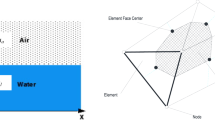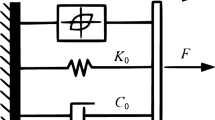Abstract
Magnetorheological (MR) damper is one of the most advanced applications of semi active damper in controlling vibration. Due to its continuous controllability in both on and off state its practice is increasing day by day in the vehicle suspension system. MR damper’s damping force can be controlled by changing the viscosity of its internal magnetorheological fluids (MRF). But still there are some problems with this damper such as MR fluid’s sedimentation, optimal design configuration considering all components of the damper. In this paper both 2-D Axisymmetric and 3-D model of MR Damper is built and finite element analysis is done for design optimization. Different configurations of MR damper piston, MR fluid gap, air gap and Dampers housing are simulated for comparing the Dampers performance variation. From the analytical results it is observed that among different configurations single coil MR damper with linear plastic air gap, top and bottom chamfered piston end and medium MR fluid gap shows better performance than other configurations by maintaining the same input current and piston velocity. Further an experimental analysis is performed by using RD-8041-1 MR Damper. These results are compared with the optimized MR Damper’s simulation results, which are clearly validating the simulated results.
Similar content being viewed by others
References
Alghamdi, Ali A, Ruben Lostado and Abdul-Ghani Olabi, Magneto-Rheological Fluid Technology, In Modern Mechanical Engineering, Springer (2014) 43–62.
Yamanaka, Shinya, Hiroya Abe and Makio Naito, Two-step surface modification of iron particles for magnetorheological fluid, Transactions of JWRI, 42 (2) (2013) 29–31.
Isoda, Haruo, Yasuhide Ohkura, Takashi Kosugi, Masaya Hirano, Marcus T Alley, Roland Bammer, Norbert J Pelc, Hiroki Namba and Harumi Sakahara, Comparison of hemodynamics of intracranial aneurysms between mr fluid dynamics using 3d cine phase-contrast MRI and MR-based computational fluid dynamics, Neuroradiology, 52 (10) (2010) 913–920.
Singh, Harinder J and Norman M Wereley, Optimal control of gun recoil in direct fire using magnetorheological absorbers, Smart materials and Structures, 23 (5) (2014) 055009.
Powell, Louise A, Wei Hu and Norman M Wereley, Magnetorheological fluid composites synthesized for helicopter landing gear applications, Journal of Intelligent Material Systems and Structures, 24 (9) (2013) 1043–48.
Gharapurkar, Ajinkya A, Ali Fellah Jahromi, Rama B Bhat and Wen-Fang Xie, Semi-active control of aircraft landing gear system using h-infinity control approach, Paper presented at the International Conference on Connected Vehicles and Expo (ICCVE), IEEE (2013) 679–686.
Atabay, Elmas and Ibrahim Ozkol, Application of a magnetorheological damper modeled using the current-dependent bouc-wen model for shimmy suppression in a torsional nose landing gear with and without freeplay, Journal of Vibration and Control (2013) 1077546312468925.
Chitragari, Gautham, David B Mahler, Brandon J Sumpio, Peter A Blume and Bauer E Sumpio, Prosthetic options available for the diabetic lower limb amputee, Clinics in podiatric medicine and surgery, 31 (1) (2014) 173–85.
Nandy, Anup, Soumik Mondal, Lokesh Rai, Pavan Chakraborty and Gora Chand Nandi, A study on damping profile for prosthetic knee, Paper presented at the proceedings of the international Conference on Advances in Computing, Communications and Informatics (2012) ACM 511-517.
Nandy, Anup, Soumik Mondal, Pavan Chakraborty and Gora Chand Nandi, Development of a robust microcontroller based intelligent prosthetic limb, In Contemporary Computing, Springer (2012) 452–62.
Nguyen, QH, Seung-Bok Choi and JK Woo, Optimal design of magnetorheological fluid-based dampers for frontloaded washing machines, proceedings of the institution of mechanical engineers, Part C: Journal of Mechanical Engineering Science, 228 (2) (2014) 294–306.
El-Khoury, Omar and Hojjat Adeli, Recent advances on vibration control of structures under dynamic loading, Archives of Computational Methods in Engineering, 20 (4) (2013) 353–60.
Bitaraf, Maryam, Stefan Hurlebaus and Luciana R Barroso, Active and semi-active adaptive control for undamaged and damaged building structures under seismic load, Computer-Aided Civil and Infrastructure Engineering, 27 (1) (2012) 48–64.
Cha, Young-Jin, Jianqiu Zhang, Anil K Agrawal, Baiping Dong, Anthony Friedman, Shirley J Dyke and James Ricles, Comparative studies of semiactive control strategies for MR dampers: Pure simulation and real-time hybrid tests, Journal of Structural Engineering, 139 (7) (2013) 1237–48.
S. H. Zareh, M. Abbasi, H. Mahdavi and K. G. Osgouie, Semi-active vibration control of an eleven degrees of freedom suspension system using neuro inverse model of magnetorheological dampers, Journal of Mechanical Science and Technology, 26 (8) (2012) 2459–2467.
A. Sarrafan, S. H. Zareh, A. A. A. Khayyat and A. Zabihollah, Neuro-fuzzy control strategy for an offshore steel jacket platform subjected to wave-induced forces using magnetorheological dampers, Journal of Mechanical Science and Technology, 26 (4) (2012) 1179–1196.
Y.-W. Yun, H.-S. Bae and M.-K. Park, A study of the control of the blank holding force using an MR damper in a drawing press, Journal of mechanical science and technology, 24 (11) (2010) 2281–2288.
K. K. Ahn, D. Q. Truong and M. A. Islam, Modeling of a magneto-rheological (MR) fluid damper using a self tuning fuzzy mechanism, Journal of Mechanical Science and Technology, 23 (5) (2009) 1485–1499.
N Yasrebi, A Ghazavi and M M Mashhadi, Magnetorhelogical fluid dampers modeling: numerical and experimental, In: Proceeding of the 17th IASTED international conference modeling and, simulation (2006).
S. A. Khan, A. Suresh and N. S. Ramaiah, Investigation on the performance of MR damper with various piston configurations, International Journal of Engineering and Advanced Technology (IJEAT) ISSN: 2249-8958, 2 (2012).
H. H. Zhang, A magnetic design method of MR fluid dampers and FEM analysis on magnetic saturation, Journal of Intelligent Material Systems and Structures, 17 (8–9) (2006) 813–818.
Mohammad Meftahul Ferdaus, M. M. Rashid, M. M. I. Bhuiyan, Asan Gani Bin Abdul Muthalif and M. R. Hasan, Novel design of a self powered and self sensing magnetorheological damper, IOP Conference Series: Materials Science and Engineering, 53 (1) (2013) 012048.
Z. Chao, F. Tyan, S. Tu and W. S. Jeng, Finite element analysis of a magnetorheological fluid damper, Journal of the Chinese Mechanical Engineers, 3145–3149.
Walid H. El-Aouar, Finite element analysis based modeling of magneto rheological dampers, M.Sc. Virginia Polytechnic Institute and State University, USA (2002).
Q H Nguyen, S B Choi and K S Kim, Geometric optimal design of MR damper considering damping force, Control Energy and Time Constant, IOP Conference Series: Journal of Physics, IOP Publishing, 149 (1) (2009) 012076.
Nguyen, Quoc-Hung and Seung-Bok Choi, Optimal design of MR shock absorber and application to vehicle suspension, Smart materials and Structures, 18 (3) (2009) 035012.
Guglielmino, Emanuele, Tudor Sireteanu, Charles W Stammers, Gheorghe Ghita and Marius Giuclea, Semi-active suspension control, Springer (2008).
G. Yang, B. F. Spencer Jr, J. D. Carlson and M. K. Sain, Large-scale MR fluid dampers: modeling and dynamic performance considerations, Engineering Structures, 24 (3) (2002) 309–323.
G. T. Ngatu, N. M. Wereley, J. O. Karli and R. C. Bell, Dimorphic magnetorheological fluids: exploiting partial substitution of microspheres by nanowires, Smart Materials and Structures, 17 (4) (2008) 045022.
S. M. H. B. Kasemi, Experimental investigation of magnetorheological fluid damper for semi-active vibration control, M.Sc. Dissertation, International Islamic University Malaysia (2012).
B. Kasemi, A. G. a. Muthalif, M. M. Rashid and M. Rahman, Optimizing dynamic range of Magnetorheological fluid dampers: Modeling and simulation, 2011 4th International Conference on Mechatronics (ICOM), Malaysia (2011) IEEE 1–4.
Emanuele Guglielmino, Tudor Sireteanu, Charles W. Stammers, Gheorghe Ghita and Marius Giuclea, Semi-active suspension control: improved vehicle ride and road friendliness, Noise Control Engineering Journal, 57 (2) (2009) 155–155.
Author information
Authors and Affiliations
Corresponding author
Additional information
Recommended by Associate Editor Seong Beom Lee
Mohammad Meftahul Ferdaus received the B.Sc. (Eng.) degree in Electrical and Electronic engineering from Rajshahi University of Engineering and Technology, Rajshahi, Bangladesh in 2011. Now he is doing his masters in Mechatronics Engineering from International Islamic University Malaysia. He is working as a research assistant in Mechatronics Engineering Department, International Islamic University Malaysia. He has published some papers in Indexed Journals and conference proceedings. His research interests are active and semi-active vehicle suspension system, smart materials, Electric and Hybrid Vehicles.
Muhammad Mahbubur Rashid (M’07) received the B.Sc. (Eng.) degree in electrical and electronic engineering from Bangladesh University of Engineering and Technology, Dhaka, Bangladesh, in 1992, and the M.Sc. and Ph.D. degrees in electrical engineering from the University of Malaya, Kuala Lumpur, Malaysia, in 2003 and 2007, respectively. Since 2007, he has been working as an Assistant Professor and Associate Professor in the Department of Mechatronics Engineering, International Islamic University Malaysia, Kuala Lumpur. He has published more than 80 papers in journals and conference proceedings. His research interests include advanced control system and simulation and nonlinear modeling, industrial automation, instrumentation, neural networks, artificial intelligence, power electronics, and renewable energy.
Muhammad Hasibul Hasan has over ten years of research, teaching and industrial experience. He received his BEng (Hons) in Mechanical Engineering, BUET, Bangladesh, MSc (Eng) in Mechanical Engineering, Wayne State University, USA, Ph.D. in Mechanical Engineering, University of Nevada Las Vegas, USA. His current research interests are High temperature application of super alloys, ANN, Creep-Fatigue, Fracture Mechanics, Reactive scheduling, Value Engineering and Manufacturing Engineering.
Ataur Rahman, Ph.D. is a Professor in the Department of Mechanical Engineering, Faculty of Engineering, International Islamic University Malaysia since 1996. His research interests are green transportation system: EV/HEV, hybrid engine, intelligent power train for hybrid and electrical vehicle, intelligent steering system and traction control system, electromagnetic actuated CVT and intelligent air-cushion vehicle for swamp and peat terrain. He has worked in The University of Tokyo, Japan, as a Visiting Fellow on the development of integrated instrumentation systems for Autonomous Vehicles. He has published 100 Journal articles including 60 ISI listed journal from his research work.
Rights and permissions
About this article
Cite this article
Ferdaus, M.M., Rashid, M.M., Hasan, M.H. et al. Optimal design of Magneto-Rheological damper comparing different configurations by finite element analysis. J Mech Sci Technol 28, 3667–3677 (2014). https://doi.org/10.1007/s12206-014-0828-5
Received:
Revised:
Accepted:
Published:
Issue Date:
DOI: https://doi.org/10.1007/s12206-014-0828-5




